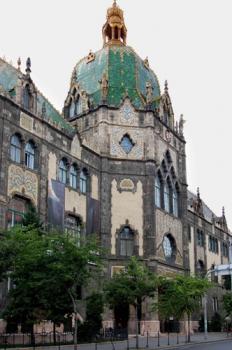
SERVICE ANNOUNCEMENT
The main building of the Museum of Applied Arts Budapest is closed due to renovations.In the museum's Collection Database nearly 42 000 works of art are available for browsing online.
Following the establishment of similar museums in London, Vienna and Berlin, and upon realizing the importance of handicrafts and industrial design, the Museum of Applied Arts in Budapest was founded by the Hungarian Parliament in 1872.
From the start, the Museum has collected applied art works contemporary and historical, from Hungary and abroad. Its collections have come from several sources.
The core of the historical collection consists of antiques transferred from the Hungarian National Museum, while the contemporary collection was originally built up from purchases at world fairs (Vienna 1873, Paris 1878, Paris 1889) and gifts by companies (Herend Porcelain Manufactory, Zsolnay).
As the collections expanded, a building was erected to accommodate them. The opening of the Museum building on 25 October 1896, attended by the monarch, Francis Joseph, was the grand event marking the end of Hungary's Millennium celebrations.
The Museum's first two directors, György Ráth (1828–1905) and Jenő Radisics (1856–1917), were internationally renowned figures who provided the Museum with extensive and lively contacts at home and abroad, and the collections benefited accordingly.
Jenő Radisics takes the credit for laying the foundations of the Art Nouveau collection, particularly through his purchases at the Paris World's Fair of 1900 and at the Christmas exhibitions held in the Museum each year. He also acquired outstanding items for the historical collection.
After Gyula Végh took over in 1917, contacts with art collectors began to dominate. The Friends of the Museum Association also took an active part in acquiring many fine items and collections.
The National Collections Alliance was set up in 1922 to collectively promote the interests of several public collections. Between 1934 and 1948, the Museum of Applied Arts temporarily lost its independence and became the applied arts branch of the Hungarian National Museum.
The Museum greatly expanded its art work holdings between the late 1940s and the early 1960s. Many of these were items rescued from large houses and palaces, and placed in the Museum by the Ministerial Commission for Endangered Private Collections. After the Communist takeover in 1948, many hitherto independent collections were wound up in the name of rationalisation (Ráth Museum, and the aristocratic Zichy and Vigyázó collections). Most of their contents survived in public collections, including the Museum of Applied Arts.
In 1948-1949, the Museum closed a major gap in its holdings by acquiring two collections: over five hundred pieces which had belonged to Ottó Fettick, and the ceramics collection of Vince Wartha, professor of chemistry and colleague of Vilmos Zsolnay. In 1961, Kiscell Museum handed over to the Museum the collection of Miksa Schmidt, a Viennese furniture manufacturer.
The additions to the collections since the 1950s have mainly been pieces related to Hungarian history or - increasingly - contemporary art works. Contemporary Hungarian art remains the principal focus of collecting today.

















